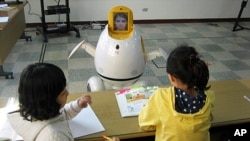Many South Korean families spend thousands of dollars a year on English language education for their children. Students attend private academies often until late at night everyday. Most such schools hire teachers from abroad, but a team of engineers has created a robot that they hope will eventually replace foreign instructors.
Engkey wheels around the front of a classroom at the Hagjeong Primary School in Daegu.
The egg-shaped robot asks the class - six fourth-grade students - to repeat English phrases and teaches them children’s songs in English.
But Engkey’s voice is not its own. It is connected via teleconference to the Philippines, where a teacher conducts the class through a monitor. An image of a Caucasian woman appears on Engkey’s LCD panel head, although she is not the teacher in the Philippines.
But Engkey’s creators say this robot is much more than a video screen on wheels.
Kim Mun-sang is director of the Intelligent Robotics Program at the government-funded Korea Institute for Science and Technology in Seoul. He explains how the robot works.
"We have some perception technology,” Kim said. “We can detect the motion of the English teacher. As soon as the teacher moves his hand, the robot raises its hand, if the teacher for example laughs, we can detect his laughing expression. So the robot can do just like the English teacher does."
Kim say Engkey also has an autonomous mode in which it can recognize a student’s English speech and correct pronunciation.
Kim says because of South Korea’s strong emphasis on learning English, robots can make up for the shortfall in foreign teachers.
"In Korea there is a lot of demand for English learning, so, they need a very good English lessons from native speakers, but as you know it is not easy to have good quality of English native teachers in Korea at once, there are not so many," Kim added.
Kim adds that Engkey will save schools money. He says the cost to build a robot and hire a Filipino teacher to work with it is around $20,000 a year. That is roughly half the cost of supporting a foreign teacher in Korea.
He says if the Engkey pilot program here in Daegu proves a success, then more robots could be used in after-school tutoring.
So far, students at the Hagjeong School give Engkey high marks.
One 10-year-old boy, who says his English name is Tony, admits he was a little nervous about the robot at first, but likes its singing and dancing
And 10-year-old Charlotte says she likes the robot teacher better than human teachers.
But some teachers think a robot cannot replace the real thing.
Yu Do-hyun lectures in English and education at Seoul’s Kookmin University.
She says Engkey’s novelty will wear off quickly.
"At first children will like to see the Engkey and play with Engkey, learning from Engkey, but after several classes, they are not interested anymore," Yu said.
And Yu adds that learning from a robot deprives students of the main reason for studying a foreign language, human interaction.
"Communication is between humans, so they need practicing with native speakers, human teachers,” Yu added. “Even though they practice English a lot with the robots, when they meet human native speakers, they will be very nervous, because they haven’t conversed with real speakers."
Engkey’s creators say that students will determine how successful the robot is as a teacher. But they hope that someday all schools in South Korea will have a robot in the classroom.
South Korean Students Learn English from Robot Teacher





